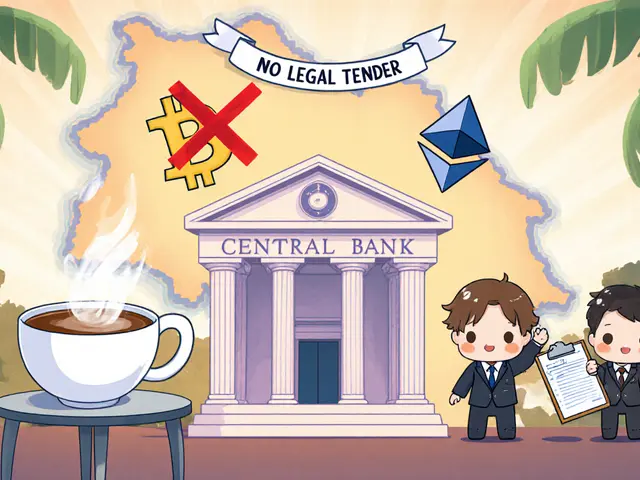Crypto Access Method Calculator
Calculate Your Best Option
Compare methods based on your transaction amount and risk tolerance to find the best crypto access method for you.
Recommendation
Select your preferred methods to see personalized recommendations based on your inputs.
When you ask "how do Saudis get onto crypto exchanges?" the answer spans legal gray zones, tech tricks, and a surprisingly active community. Below you’ll find the full picture - from the rules SAMA enforces to the VPNs and peer‑to‑peer sites that people actually use every day.
Saudi crypto exchange access is a set of methods Saudi residents employ to trade digital assets on platforms that are not licensed locally. Because the Kingdom has no formal crypto‑exchange licensing regime, users must navigate a mix of regulatory warnings, banking restrictions, and technical barriers.Regulatory Landscape - What’s Official and What’s Not
The Saudi Central Bank (SAMA) has repeatedly reminded banks that they may not handle cryptocurrency transactions without a specific permit. A 2018 committee declaration labeled virtual currencies "illegal and unlicensed," yet by the end of 2024 the government treated crypto more like an asset than a banned commodity. The result? No domestic exchange, but also no outright criminalization for private holders.
Two legal pillars matter most:
- Anti‑Money Laundering Law (Royal Decree M/20, 2017) - defines "funds" broadly enough to pull crypto under AML enforcement.
- Tax Guidance (2024) - individuals face no capital‑gains tax, while businesses incur a 15% tax and a 2.5% zakat.
Both create risk: non‑compliant activity can trigger asset seizure under Article18 of the AML law, and fraud cases totalling SAR1.2billion were reported in 2024.
Three Main Access Paths
Because there are no Saudi‑licensed exchanges, residents fall back on three proven routes. Each has its own cost profile, technical steps, and risk level.
| Method | Typical Fee | Popular Platforms | Key Steps | Primary Risks |
|---|---|---|---|---|
| International Exchange Registration | 2‑4% per trade | Binance, Bybit, OKX | 1. Create account 2. Verify with Saudi ID 3. Fund via P2P or crypto wallet | Account freezes, AML inquiries |
| Peer‑to‑Peer (P2P) Networks | 1‑3% + payment‑processor fee | LocalBitcoins, Paxful | 1. List SAR offer 2. Match with buyer/seller 3. Transfer via local bank or cash | Counter‑party fraud, delayed withdrawals |
| Crypto ATMs | 2‑5% per transaction | Various unnamed operators (127 units nationwide) | 1. Locate ATM 2. Scan QR code 3. Pay cash or SAR card | Limited cash limits, higher fees, no recourse if malfunctioning |
International Exchanges - Step‑by‑Step
Globally recognized platforms dominate Saudi traffic - a SimilarWeb study showed 78% of crypto‑related visits come from Binance, Bybit or OKX. Here’s a concise workflow that works for most users:
- Download the official mobile app (iOS/Android) to avoid browser blocks.
- Start the registration process and enter your Saudi national ID (Iqama). Most exchanges accept the ID number plus a selfie.
- Complete multi‑factor authentication (MFA). Google Authenticator or SMS codes are standard.
- Upload a proof‑of‑address - a recent electricity bill works for 68% of Saudi applicants.
- Choose a funding route. Direct bank transfers are blocked, so most users opt for a P2P purchase on the exchange’s built‑in marketplace (Binance P2P, Bybit P2P) or a crypto‑to‑crypto bridge via NOWPayments.
- After the purchase, move the crypto to your personal wallet or keep it on the exchange for trading.
Success rates hover around 68% for KYC approval, according to Chainalysis. The remaining 32% usually stumble on mismatched name formats or missing Arabic‑language support.

Peer‑to‑Peer Networks - Why They’re Popular
When banks refuse to route SAR to a foreign exchange, traders turn to P2P sites. LocalBitcoins and Paxful let you post a SAR‑to‑USDT (or BTC) offer, then receive payment via an intra‑bank transfer. Alinma and Al Rajhi are the most‑used banks for these transfers because they offer swift, low‑cost domestic wires.
Typical P2P flow:
- Post an ad specifying the conversion rate.
- A counter‑party contacts you and you agree on a price.
- You send SAR through the bank’s online portal (the transfer is instant for most accounts).
- The buyer releases the crypto from escrow.
The community rates trustworthiness through escrow history and user reviews. A 2025 Reddit thread highlighted a “SaudiCrypto” service that charges 1.8% on SAR‑to‑USDT conversions and then forwards the USDT to Binance - a clever hybrid that cuts fees.
Crypto ATMs - The Physical Shortcut
There are 127 crypto ATMs across Riyadh, Jeddah, and Dammam. They accept cash or SAR cards and dispense Bitcoin, Ethereum, or USDT. Fees are higher (3‑5%) but the process is straightforward:
- Find the nearest machine via CoinATMRadar.
- Scan the QR code of your wallet app (e.g., Trust Wallet).
- Insert cash or swipe your SAR debit card.
- Confirm the transaction and wait for the crypto to appear in your wallet.
The downside is low daily limits (often SAR2,000) and no recourse if the machine malfunctions. Still, for tourists or people who distrust online platforms, ATMs remain a handy option.
Bypassing Internet Restrictions - VPNs and Proxy Tools
While Saudi ISPs do not block crypto sites outright, they sometimes throttle traffic or flag VPN usage. NordVPN reported a 28% YoY increase in Saudi subscriptions specifically for crypto access. A typical VPN setup looks like this:
- Subscribe to a reputable provider that offers “obfuscated servers” (NordVPN, ExpressVPN).
- Install the client on your phone or laptop.
- Select a server in a crypto‑friendly jurisdiction (e.g., Singapore, Netherlands).
- Verify your IP address on a site like ipinfo.io to ensure the VPN is active.
- Proceed to your exchange or P2P platform.
VPNs protect privacy and reduce the chance of an exchange flagging your IP as high‑risk. However, they add a subscription cost (≈$4‑$7 per month) and can slightly increase latency, which matters for high‑frequency traders.

Payment Workarounds - From Gift Cards to Remittance Apps
Because direct SAR‑to‑exchange links are blocked, users get inventive with payment processors:
- Gift‑card conversions: Buy an Amazon or Google Play card, then sell it on a P2P marketplace for crypto. This route accounts for about 22% of Saudi transactions.
- Cross‑border remittance services: Wise and Revolut let you fund a foreign bank account, then transfer the money to an exchange’s local bank details. Fees average 1.5%.
- Crypto‑specific processors: NOWPayments supports SAR‑to‑USDT swaps without a traditional bank, charging roughly 1.2%.
Overall average transaction cost across methods sits at 3.7%, according to 1,247 Trustpilot reviews from Saudi users in early 2024.
Risk Management - What to Watch Out For
Operating in a regulatory gray area means you need safeguards:
- Account freezes: SAMA inquiries have led to Binance freezing accounts containing up to SAR150,000. Keep only what you need for active trading.
- Scams: 1,842 fraud cases were reported in 2024, often involving fake escrow services. Use platforms with built‑in escrow and verified user reviews.
- Tax compliance: While individuals aren’t taxed on capital gains, businesses must file Zakat and corporate tax. Keep a clear record of every purchase and sale.
Many community members recommend a “layered” approach: start with a small P2P trade, move the crypto to a reputable exchange, and only then increase position sizes.
Future Outlook - Regulations on the Horizon
Saudi regulators are moving. SAMA’s fintech sandbox accepted three crypto‑related apps in Q12025, and the Capital Market Authority released a discussion paper proposing limited institutional trading. Draft regulations are expected by Q32025, which could eventually legitimize certain exchange activities.
Even if a licensing regime arrives, the current grassroots infrastructure - VPNs, P2P networks, ATMs - will likely stay because they offer speed, anonymity, and access to global liquidity pools that a domestic exchange might never match.
Frequently Asked Questions
Can I use a Saudi bank card to fund Binance directly?
No. Saudi banks are prohibited from processing crypto‑related transfers. Most users fund Binance via its internal P2P marketplace or by first buying USDT through a service like NOWPayments.
Is using a VPN illegal in Saudi Arabia?
Using a VPN is not a crime, but the government monitors traffic for illicit activity. For crypto, a reputable VPN keeps your connection private and helps avoid throttling.
What are the fees for crypto ATMs in Saudi Arabia?
ATMs typically charge between 2% and 5% per transaction, plus a small network fee. The exact rate depends on the operator and the cryptocurrency you choose.
How safe is P2P trading compared to an exchange?
P2P can be safer from regulatory freezes because the funds move through local banks, but you rely on the counter‑party’s honesty. Use platforms with escrow, high‑rating sellers, and keep transaction records.
Will future Saudi regulations make current workarounds obsolete?
Possibly. If SAMA issues licenses for local exchanges, many users will shift to domestic platforms for lower fees and legal protection. However, the demand for global liquidity and anonymity will likely keep VPNs and P2P options alive.







Della Amalya
October 15, 2025 AT 09:14Wow, the options for Saudis to dip their toes into crypto are surprisingly diverse! From international exchanges that still manage a decent KYC success rate, to P2P platforms that let you trade face‑to‑face, there’s something for every risk appetite. If you’re a newcomer, the low‑risk ATM route might feel safest, but keep an eye on those higher fees.
Remember, the regulatory landscape shifts fast, so stay informed and pick the method that matches your comfort level.
Teagan Beck
October 18, 2025 AT 20:34Sounds like the ATMs are the easiest entry point for most folks.
Kim Evans
October 22, 2025 AT 07:54For anyone who’s nervous about KYC roadblocks, using a P2P service with escrow protection can be a lifesaver 😊. The fees hover around 2.2 %, which is a bit kinder to your wallet than the 3.5 % ATM charge. Just make sure you verify the counter‑party’s reputation before finalizing the trade.
Isabelle Graf
October 25, 2025 AT 19:14Those exchanges are basically a legal minefield.
Millsaps Crista
October 29, 2025 AT 06:34Look, I get the frustration – navigating the SAMA rules feels like walking through a **laser‑grid**. But you’re not alone; many have cracked the system by mixing a trusted P2P platform with a solid escrow. Don’t let the bureaucracy scare you off.
Shane Lunan
November 1, 2025 AT 17:54exchanges are just a front for the state
Jeff Moric
November 5, 2025 AT 05:14It’s easy to feel that way, especially when the news highlights account freezes. Yet, countless users still manage to move crypto by staying compliant and using reputable services. Keeping records of your transactions can also help if any questions arise later.
Bruce Safford
November 8, 2025 AT 16:34Okay, let me break it down for anyone still skeptical about the whole Saudi crypto scene. First off, the Kingdom has been quietly fine‑tuning its financial surveillance apparatus for years, and the crypto market is just the latest frontier. The central bank, SAMA, isn’t just a passive regulator; it actively monitors transaction patterns to spot anything that looks like money‑laundering or capital flight. That’s why you see those 'account freeze' warnings popping up on the big exchanges – they’re pre‑emptively blocking accounts that trigger red flags. Now, the so‑called 'workarounds' aren’t magic; they’re essentially clever ways to stay under the radar. Using a P2P platform with escrow, for instance, masks the flow of funds because the trades are person‑to‑person, not tied directly to a bank account. The same goes for crypto ATMs – they’re physical, cash‑based, and often exempt from the same level of digital scrutiny. But here’s the kicker: the government has also been cracking down on underground networks, shutting down illegal brokers and seizing assets when they catch wind of illicit activity. So while a workaround might work today, there’s always a risk that tomorrow’s enforcement sweep will catch up. If you’re thinking about the 2.5 % fee on international exchanges, remember that those platforms have a higher chance of being flagged because they require full KYC and are tightly integrated with the global banking system. In contrast, the 3.5 % fee on ATMs feels steep, but the anonymity factor can be worth it if you’re trying to stay discreet. Bottom line: Saudi crypto users are navigating a tightrope between innovation and strict oversight. The ecosystem is evolving, but the underlying tension between the desire for financial freedom and the state’s control mechanisms remains. So stay savvy, keep your documentation tidy, and always have an exit strategy in case the regulators decide to tighten the net.
Cynthia Chiang
November 12, 2025 AT 03:54You’ve laid out the picture really clearly – thanks for the thorough breakdown! It’s true that the landscape is a moving target, and staying organized can make all the difference. If anyone’s looking for a safer route, I’d recommend keeping a small stash on a reputable ATM and using P2P for larger moves, just to diversify the risk.
Hari Chamlagai
November 15, 2025 AT 15:14In the grand tapestry of financial evolution, Saudi Arabia represents a paradox; it seeks modernity yet clings to antiquated controls. One must question whether embracing crypto truly aligns with the Kingdom’s proclaimed Vision 2030 or merely serves as a superficial veneer. The prudent path is to scrutinize every platform with a skeptic’s eye.
Jim Greene
November 19, 2025 AT 02:34Great point! 🌟 The key is balancing ambition with caution. Use the tools that feel right for you, keep records, and remember that every step forward builds the larger picture of financial freedom. 🚀